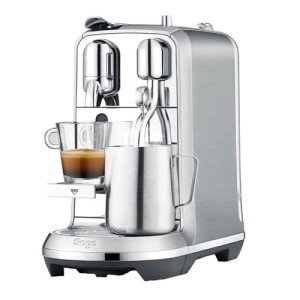A Journey Back In Time What People Talked About Home Use Espresso Machines 20 Years Ago
Home Use Espresso Machines: A Comprehensive Guide
Espresso machines have ended up being a staple in lots of homes as coffee lovers look for to replicate café-quality brews in the comfort of their kitchen areas. The increase in popularity has led to a diverse market filled with numerous designs, features, and prices. This short article aims to provide a helpful introduction of home use espresso machines, assisting readers browse their options efficiently.
Comprehending Espresso Machines
Espresso machines work by requiring warm water through finely-ground coffee under high pressure, leading to a concentrated coffee beverage called espresso. There are several kinds of espresso machines categorized based upon their developing methods and level of automation. The most typical types include:
Manual Espresso Machines: These require the user to manage the pressure and water flow, enabling for a more hands-on coffee-making experience.
Semi-Automatic Espresso Machines: These use automatic control over water pressure, while the user by hand grinds and tamps the coffee.
Automatic Espresso Machines: With the push of a button, these machines instantly manage the circulation of water, making it easier to brew espresso with constant results.
Super-Automatic Espresso Machines: These all-in-one machines handle grinding, tampering, developing, and even milk frothing, making them ideal for users trying to find benefit.
Capsule or Pod Machines: These use pre-packaged coffee pods to create espresso with minimal effort, however they limit option in brewing methods and tastes.
Table: Comparison of Espresso Machine Types
Type
Control Level
Relieve of Use
Cleaning Level
Ideal For
Manual
User-controlled
Moderate
High
Coffee perfectionists
Semi-Automatic
Partial automation
Moderate
Moderate
Home baristas
Automatic
Totally automated
Easy
Low
Hectic individuals
Super-Automatic
Completely automated
Really simple
Really low
Convenience seekers
Capsule/Pod
Completely automated
Extremely easy
Very low
Casual drinkers
Key Features to Consider
When choosing a home use espresso machine, it's necessary to think about various functions that can considerably impact the quality of espresso and user experience.
Pressure: Look for machines that supply a minimum of 9 bars of pressure, as this is considered optimal for brewing espresso.
Boiler Systems: Single vs. dual boiler systems determine temperature level stability and the capability to brew espresso and steam milk simultaneously.
Grinder: Integrated mills permit newly ground coffee, which boosts flavor. Consider machines with adjustable grind settings.
Milk Frother: For those who enjoy coffees and lattes, an integrated steam wand or automatic frother is crucial.
Size and Design: Consider your kitchen space and visual choices. Machines can be found in various sizes, from compact to large setups.
Cost: Home espresso machines can range from a few hundred to a number of thousand dollars, so it's crucial to develop a budget before checking out options.
Pros and Cons of Home Use Espresso Machines
Pros
Cons
Convenience of brewing coffee in your home
Initial investment can be high
Quality of espresso is typically exceptional
Needs some skill, particularly with manual machines
Ability to experiment with tastes
Maintenance and cleaning can be labor-intensive
Can conserve money in the long run
Not all machines will fit every coffee choice
Maintenance and Cleaning Tips
Keeping an espresso machine is essential for prolonging its life and ensuring constant brew quality. Here are some helpful pointers:
Regular Descaling: Minerals from water can develop in the machine. Descale every 1-3 months, depending upon water solidity.
Daily Cleaning: Rinse portafilters, baskets, and steam wands after each use to prevent coffee oils from building residue.
Use Filtered Water: This can assist lower mineral buildup and improve the taste of coffee.
Change Gaskets and Seals: These parts may break in time and must be changed to preserve pressure and efficiency.
Read the Manual: Each machine has particular care directions; following these will make sure longevity.
Frequently Asked Questions About Home Use Espresso Machines
**Q1: What is the very best budget espresso machine?The best budget espresso machine frequently depends on specific requirements, but designs like the DeLonghi EC155 or the Breville Bambino are popular amongst users for providing terrific worth. Q2: How long do home espresso machines usually last?With Bean To Cup Espresso Machines , home espresso machines can last anywhere from 5 to 15 years, depending on the quality of the machine and frequency of use. Q3: Can I make cappuccinos and lattes with any espresso machine?While most espresso machines can make cappuccinos and lattes, having a dependable
steam wand or frother is necessary for achieving the best milk texture.
Q4: Are super-automatic machines worth the investment?For those who prioritize convenience and quick brewing, super-automatic machines can be worth the financial investment, though they may do not have some customizability in brew strength and taste. Q5: What kinds of coffee beans are best for espresso?While personal preference plays a role, beans labeled as” espresso “blends are normally roasted darker, developing rich flavors and a velvety texture when brewed.
Purchasing a home espresso machine can transform the day-to-day coffee routine into something special, elevating home brews to café quality. By comprehending the various kinds of machines, essential features to consider, maintenance requirements, and weighing the
advantages and disadvantages, consumers can make educated choices that suit their private choices. As the espresso culture continues to grow, no matter the choice, every brew can be a scrumptious experience waiting to be appreciated.  **
**